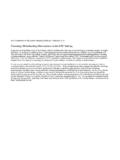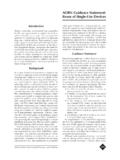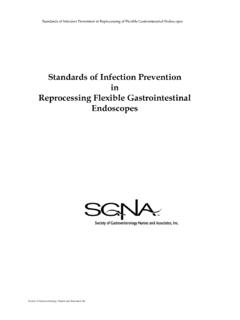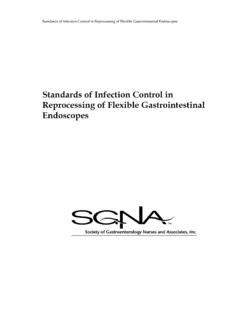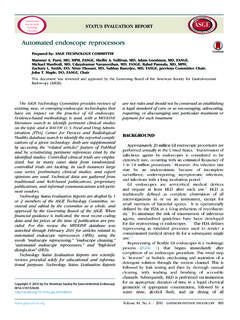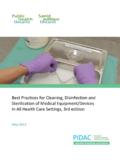Transcription of Guideline for Disinfection and Sterilization in Healthcare ...
1 Guideline for Disinfection and Sterilization in Healthcare Facilities, 2008. developed in response to disinfectant exposure 334, 335, 346, 347, 361. However, the level of tolerance is not important in clinical terms because it is low and unlikely to compromise the effectiveness of disinfectants of which much higher concentrations are used 347, 362. The issue of whether low-level tolerance to germicides selects for antibiotic-resistant strains is unsettled but might depend on the mechanism by which tolerance is attained. For example, changes in the permeability barrier or efflux mechanisms might affect susceptibility to both antibiotics and germicides, but specific changes to a target site might not.
2 Some researchers have suggested that use of disinfectants or antiseptics ( , triclosan) could facilitate development of antibiotic-resistant microorganisms 334, 335, 363. Although evidence in laboratory studies indicates low-level resistance to triclosan, the concentrations of triclosan in these studies were low (generally <1 g/mL) and dissimilar from the higher levels used in antimicrobial products (2,000 20,000 g/mL) 364, 365. Thus, researchers can create laboratory-derived mutants that demonstrate reduced susceptibility to antiseptics or disinfectants. In some experiments, such bacteria have demonstrated reduced susceptibility to certain antibiotics 335. There is no evidence that using antiseptics or disinfectants selects for antibiotic-resistant organisms in nature or that such mutants survive in nature366.
3 In addition, the action of antibiotics and the action of disinfectants differ fundamentally. Antibiotics are selectively toxic and generally have a single target site in bacteria, thereby inhibiting a specific biosynthetic process. Germicides generally are considered nonspecific antimicrobials because of a multiplicity of toxic-effect mechanisms or target sites and are broader spectrum in the types of microorganisms against which they are effective 344, 347. The rotational use of disinfectants in some environments ( , pharmacy production units) has been recommended and practiced in an attempt to prevent development of resistant microbes 367, 368. There have been only rare case reports that appropriately used disinfectants have resulted in a clinical problem arising from the selection or development of nonsusceptible microorganisms 369.
4 Surface Disinfection Is Surface Disinfection Necessary? The effective use of disinfectants is part of a multibarrier strategy to prevent health-care . associated infections. Surfaces are considered noncritical items because they contact intact skin. Use of noncritical items or contact with noncritical surfaces carries little risk of causing an infection in patients or staff. Thus, the routine use of germicidal chemicals to disinfect hospital floors and other noncritical items is controversial 370-375. A 1991 study expanded the Spaulding scheme by dividing the noncritical environmental surfaces into housekeeping surfaces and medical equipment surfaces 376. The classes of disinfectants used on housekeeping and medical equipment surfaces can be similar.
5 However, the frequency of decontaminating can vary (see Recommendations). Medical equipment surfaces ( , blood pressure cuffs, stethoscopes, hemodialysis machines, and X-ray machines) can become contaminated with infectious agents and contribute to the spread of health-care associated infections 248, 375. For this reason, noncritical medical equipment surfaces should be disinfected with an EPA-registered low- or intermediate-level disinfectant. Use of a disinfectant will provide antimicrobial activity that is likely to be achieved with minimal additional cost or work. Environmental surfaces ( , bedside table) also could potentially contribute to cross- transmission by contamination of health-care personnel from hand contact with contaminated surfaces, medical equipment, or patients 50, 375, 377.
6 A paper reviews the epidemiologic and microbiologic data (Table 3) regarding the use of disinfectants on noncritical surfaces 378. Of the seven reasons to usie a disinfectant on noncritical surfaces, five are particularly noteworthy and support the use of a germicidal detergent. First, hospital floors become contaminated with microorganisms from settling airborne bacteria: by contact with shoes, wheels, and other objects; and occasionally by spills. The removal of microbes is a component in controling health-care associated infections. In an investigation of the cleaning of hospital floors, the use of soap and water (80% reduction). was less effective in reducing the numbers of bacteria than was a phenolic disinfectant (94% 29.)
7 Guideline for Disinfection and Sterilization in Healthcare Facilities, 2008. reduction) 379. However, a few hours after floor Disinfection , the bacterial count was nearly back to the pretreatment level. Second, detergents become contaminated and result in seeding the patient's environment with bacteria. Investigators have shown that mop water becomes increasingly dirty during cleaning and becomes contaminated if soap and water is used rather than a disinfectant. For example, in one study, bacterial contamination in soap and water without a disinfectant increased from 10 CFU/mL to 34,000 CFU/mL after cleaning a ward, whereas contamination in a disinfectant solution did not change (20 CFU/mL) 380.
8 Contamination of surfaces close to the patient that are frequently touched by the patient or staff ( , bed rails) could result in patient exposures0 381. In a study, using of detergents on floors and patient room furniture, increased bacterial contamination of the patients' environmental surfaces was found after cleaning (average increase = CFU/24cm2) 382. In addition, a P. aeruginosa outbreak was reported in a hematology-oncology unit associated with contamination of the surface cleaning equipment when nongermicidal cleaning solutions instead of disinfectants were used to decontaminate the patients' environment 383 and another study demonstrated the role of environmental cleaning in controlling an outbreak of Acinetobacter baumannii 384.
9 Studies also have shown that, in situations where the cleaning procedure failed to eliminate contamination from the surface and the cloth is used to wipe another surface, the contamination is transferred to that surface and the hands of the person holding the cloth381, 385. Third, the CDC Isolation Guideline recommends that noncritical equipment contaminated with blood, body fluids, secretions, or excretions be cleaned and disinfected after use. The same Guideline recommends that, in addition to cleaning, Disinfection of the bedside equipment and environmental surfaces ( , bedrails, bedside tables, carts, commodes, door-knobs, and faucet handles) is indicated for certain pathogens, , enterococci, which can survive in the inanimate environment for prolonged periods 386.
10 Fourth, OSHA requires that surfaces contaminated with blood and other potentially infectious materials ( , amniotic, pleural fluid) be disinfected. Fifth, using a single product throughout the facility can simplify both training and appropriate practice. Reasons also exist for using a detergent alone on floors because noncritical surfaces contribute minimally to endemic health-care associated infections 387, and no differences have been found in Healthcare associated infections rates when floors are cleaned with detergent rather than disinfectant 382, 388, 389.. However, these studies have been small and of short duration and suffer from low statistical power because the outcome Healthcare associated infections is of low frequency.
